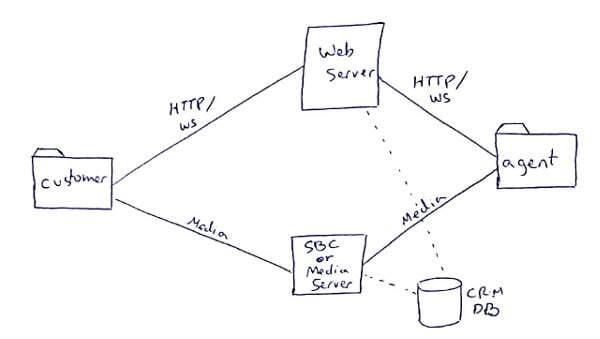There’s a new home for the WebRTC Data Channel – it found its use lately in context.
Ever since WebRTC was announced, I’ve been watching the data channel closely – looking to see what developers end up doing with it. There are many interesting use cases out there, but for the most part, it is still early days to decide where this is headed. In the last couple of weeks though, I’ve seen more and more evidence that there’s one place where the WebRTC Data Channel is being used – a lot more than I’d expect. That place is in adding context to a voice or video call.
Where did my skepticism come from?
Look at this diagram, depicting a simplified contact center using WebRTC:

We have a customer interacting with an agent, and there are almost always two servers involved:
- The web server, which got the two browsers connected. It acts as the signaling server for us, and uses HTTP or Websockets for its transport
- The media server, which can be an SBC, connecting both worlds or just a media server that is there to handle call queuing, record calls, etc.
The logic here is that the connection to the web server should suffice to provide context – why go through all the trouble of opening up a data channel here? For some reason though, I’ve seen evidence that many are adopting the data channel to pass context in such scenarios – and they are terminating it in their server side and not passing it direct between the browsers.
The question then is why? Why invest in yet another connection?
#1 – Latency
If you do need to go from browser to browser, then why make the additional leg through the signaling server?
Going direct reduces the latency, and while it might not be much of an issue, there are use cases when this is going to be important. When the type of context we are passing is collaboration related, such as sharing mouse movements or whiteboarding activity – then we would like to have it shared as soon as possible.
#2 – Firewalls
We might not want to go through the signaling server for the type of data we wish to share as context. If this is the case, then the need to muck around with yet another separate server to handle a Websocket connection might be somewhat tedious and out of context. Having the WebRTC data channel part of the peer connection object, created and torn down at the same time can be easier to manage.
It also has built in NAT and Firewall traversal mechanisms in place, so if the call passes – so will the context – no need to engineer, configure and test another system for it.
#3 – Asymmetry
At times, not both sides of the session are going to use WebRTC. The agent may as well sit on a PSTN phone looking at the CRM screen on his monitor, or have the session gateway into a SIP network, where the call is received.
In such cases, the media server will be a gateway – a device that translates signaling and media from one end to the other, bridging the two worlds. If we break that apart and place our context in a separate Websocket, then we have one more server to handle and one more protocol to gateway and translate. Doing it all in the gateway that already handles the translation of the media makes more sense for many use cases.
#4 – Load Management
That web server doing signaling? You need it to manage all sessions in the system. It probably holds all text chats, active calls, incoming calls waiting in the IVR queue, etc.
If the context we have to pass is just some log in information and a URL, then this is a non-issue. But what if we need to pass things like screenshots, images or files? These eat up bandwidth and clog a server that needs to deal with other things. Trying to scale and load balance servers with workloads that aren’t uniform is harder than scaling uniform work loads.
#5 – Because We Can
Let’s face it – WebRTC is a new toy. And the data channel in WebRTC is our new shiny object. Why not use it? Developers like shiny new toys…
The Humble WebRTC Data Channel
The data channel has been around as long as WebRTC, but it hasn’t got the same love and attention. There’s very little done with it today. This new home it found with passing context of sessions is an interesting development.
